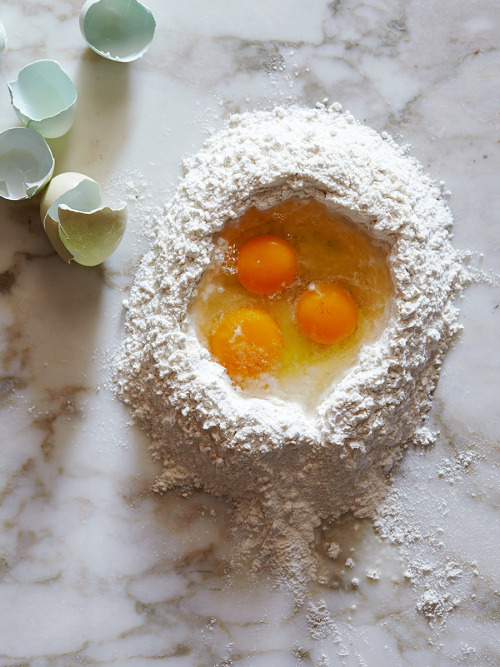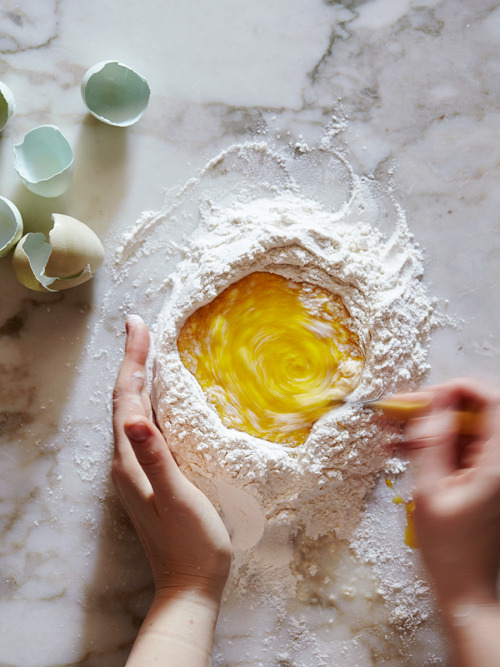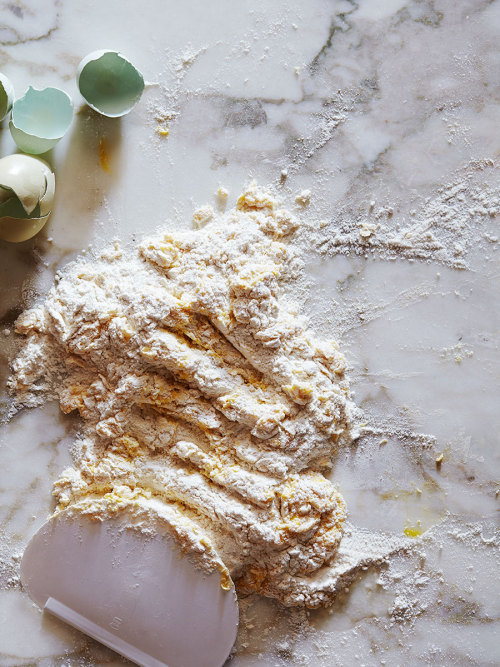#tagliolini
Filippo Tagliolini (Fogliano Cascia 1745 - 1809 Naples), a Neaples Biscuit, made in Real Fabbrica di Napoli, Bacchus and Cupid, ca.1790, Sotheby’s sale in 2011
Post link

Tajarin al tarfufo bianco d’Alba
The Perfect Egg Dough
My first attempt at fresh pasta was an egg dough. After all, it is THE dough for fresh pasta. At least that’s what google tells me. And it’s “simple”. Just wazz it all up in your food processor and your good to go. There are a million recipes to choose from with varying amounts of salt, olive oil, water, egg yolks, whole eggs, AP flour, 00 flour, semolina… for something so simple, the variations are seemingly endless.
My first attempt at an egg dough was a complete flop. So was the 50th. It was always too tough to work with. No matter what recipe I tried. Sure I could put together a dough that was tasty enough, but I hadn’t found the rightone.
Finally last year, I studied pasta in Bologna, the center for fresh pasta in Italy. The Bolognese egg dough is like a pillow. So soft and easy to work with, the perfect bite; everything about it is ideal.
The recipe is simple, straight forward, and never fails:
per person, 100g 00 flour, 60g liquid (egg + warm water if needed)
As in all things Italian, you must use the best ingredients you can find.
The only flour to consider is 00 flour. Period.
You want your eggs to be big and fresh with bright orange yolks. In Italy there are eggs at the market specifically for pasta. The closest I’ve been able to find in the States are Pete & Gerry’s beautiful blue Heirloom Eggs (available at Whole Foods). Sometimes even these beauties aren’t equal to 60g each, so just add warm water until you get there. I prefer to use the fontana method pictured here, but you can definitely use your food processor… if you must. But honestly, we aren’t making fresh pasta every day, pour yourself a nice glass of wine, and do it slowly, at a moment when you have the time. It’s a beautiful process, I promise you’ll enjoy it more this way.
Weigh the flour. Pour it directly onto your work surface. Burrow a hole in the middle— deeper rather than wider, go all the way to the surface so the walls are as high as they can be.
Measure your liquid and carefully place it in the middle. Using a fork, with care, beat the eggs. Once they are combined as you would do for an omelet, begin to grab a little flour at a time from the edges, and continue to whisk. Repeat this process of incorporating a little flour at time and slowly but surely you will end up with a gloppy egg mixture that begins to pull away from the surface and is now too thick to beat. At this point, you are done with the fork. Roll up your sleeves, grab a pastry scraper and with confidence, starting at the bottom of the flour, scrape up through to the top, to clean any wet ingredients from the surface. Use the scraper to mix further, continuing to scrape the surface and mashing up the pieces of the dough. Once you can bring it together with your hands, do so, set it aside and clean off your surface and your hands. You don’t want all those small, dry bits of dough in your pasta. They will only keep the final dough from being as even and smooth as possible.
Now, you knead. Set yourself up with a finger bowl of warm water— I personally also like to have a water spray bottle on hand. As you knead, midway through, the dough may become drier and harder to work with, as it will be exposed to the air for quite a while. If this happens, simply dip your fingers in the water and continue kneading. Dip too much? Sprinkle with a little more flour. It’s important to remember not to have the dough covered with flour, however tempting it may be. Unless it’s sticking to your hands or your work surface, you shouldn’t add any. You want to have traction when kneading, and more flour will just have you slipping and sliding all over your work surface and create a rock hard dough.
Please be aware, weather can play a part in this too. If it’s very warm and humid you will need less liquid. As the amount is difficult to determine, it’s easier to just sprinkle a bit more flour incorporating slowly as you go if necessary.
Don’t strangle the dough, massage it using the palm of your hand. Not sure what I mean? Watch this master Nonna, starting at 3:10. She is working with the gloriously simple semolina + water dough, but the kneading technique is universal. You can learn everything I know about that dough here.
Knead for 10-15 minutes. How can you tell when you’re done? Take a chef’s knife and slice the dough directly down the middle. If you see air bubbles, keep going (the one pictured needs 3 more minutes or so). What you want in the end is a seamless, smooth dough inside and out. When it’s ready, cover it with cling wrap and leave it out to rest for at least 30 minutes. If you will not roll out the dough within an hour or so, put it the fridge. It will keep for 3 days. When you are going to use it, leave it out for at least 30 minutes so it can come to room temperature. It will make your life much easier.
At this point you are ready to make tagliatelle, pappardelle, lasagna, filled pasta and more!
Post link





